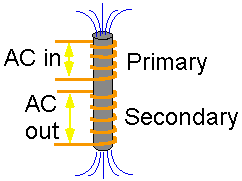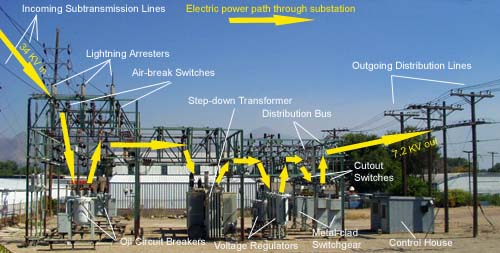To step down the Voltage |
 |
A transformer uses alternating current in one coil to induce alternating current in another. The induced voltage is given by: Vout = Vin x N2/N1 where N1 = Number of coils in the Primary and N2= Number of coils in the secondary. When N2 is less than N1, we reduce Vout. This is why there are transformers on power lines to step the voltage down to 120 Volts by the time it reaches your house. |
Energy conservation tells us that Power In = Power Out
So if the voltage OUT is less than the voltage IN, then the current OUT is higher than the current IN. This can be see directly here:
The voltage step downs in a neighborhood substation are about a factor of 10. This is why a typical electricity substation is physically large:

All have to be grid connected
 why the move
to 765 KV has serious cost reductions and reduced losses.
why the move
to 765 KV has serious cost reductions and reduced losses.



So what's the problem.
Higher voltage means stronger
localized electromagentic fields (EMF) which would adversely affect local
biology - if there is any. Currently the most at risk population would be
bats.
Note, 765 KV lines do exist already in the world and even in some parts of the US.
The proposal is to build the equivalent of the interstate highway system
with 765 KV transmission because a) its cost effective and b) its needed to export
wind and solar based electricity from remote areas.